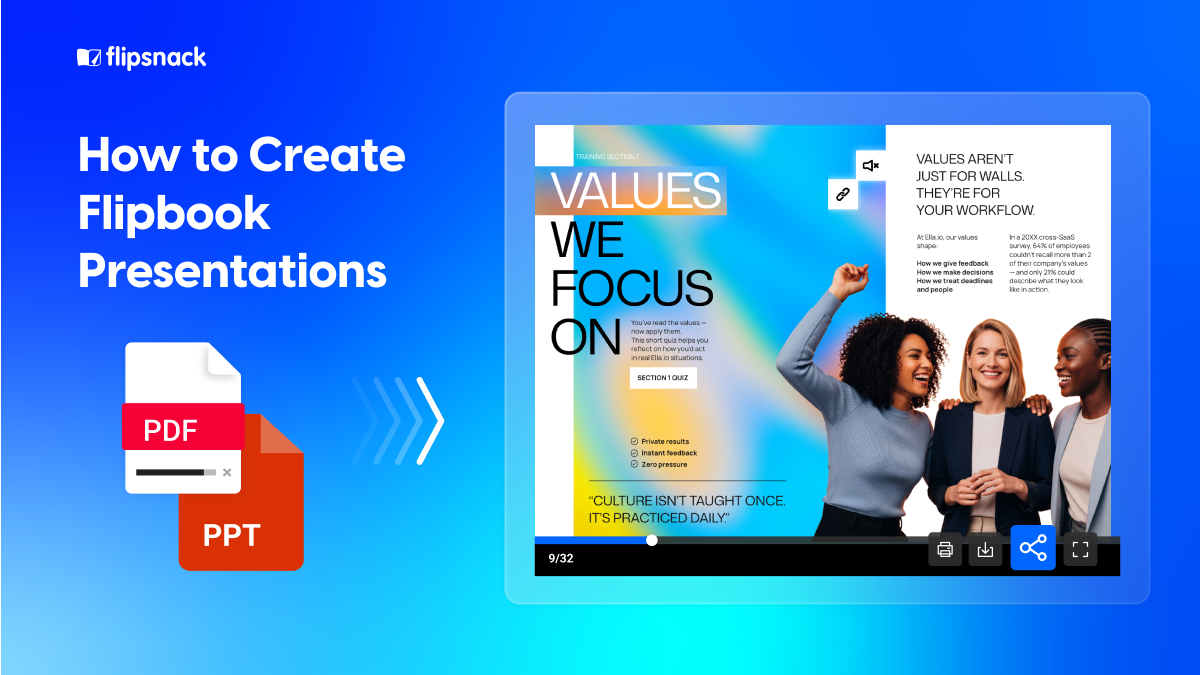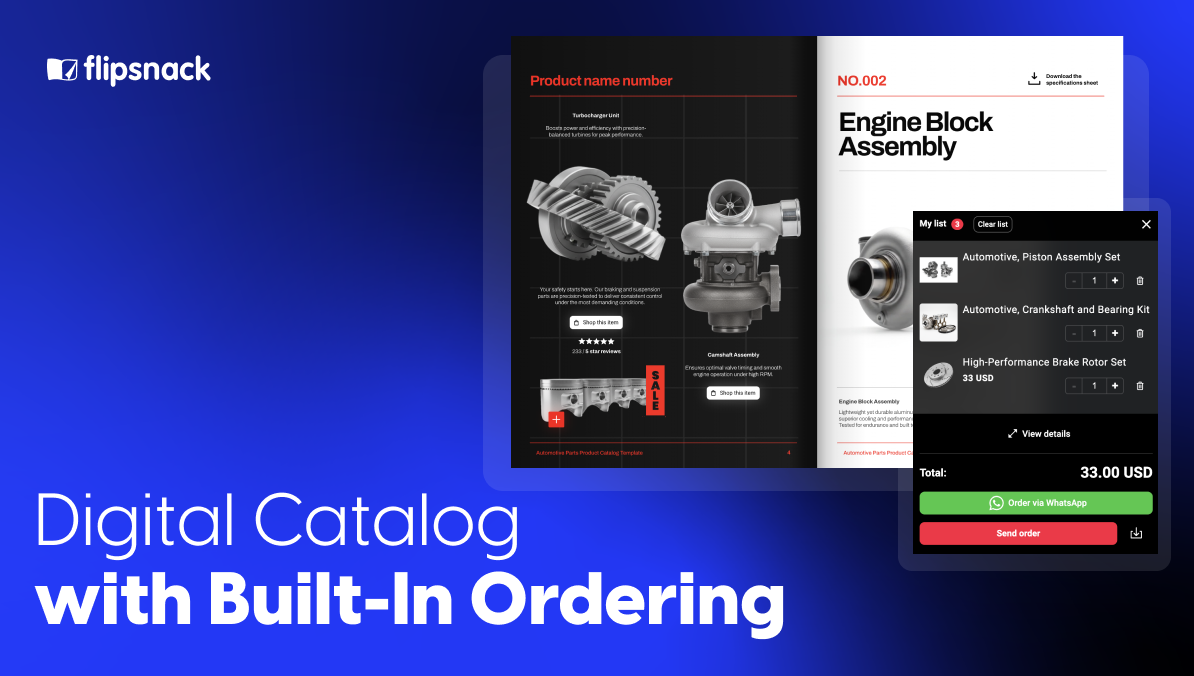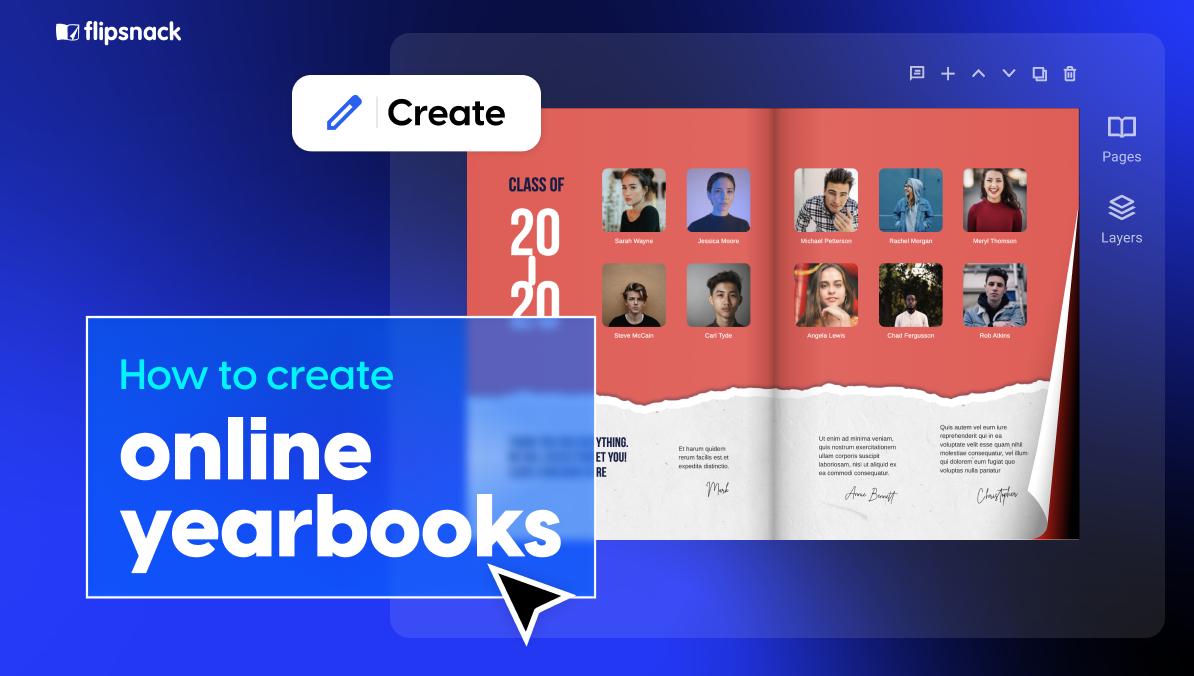Guide on How to Create Flipbook Presentations Using Flipsnack
Published on: December 8, 2024
Last updated: September 19, 2025
We’ve all sat through a boring presentation—a seemingly endless stream of static slides with too much text and not enough life. It’s the kind of experience that makes you check your watch and hope for a quick end.
Or someone shared a PowerPoint presentation with us and it was impossible to view it from a mobile device.
But what if there was a better way to share your message? What if you could transform a dull PDF or an unresponsive PowerPoint into something dynamic, engaging, and interactive?
There is. You can use flipbook presentations instead. And with the right platform, you can get so much more than just visual appeal.
You can create flipbook presentations or PowerPoint flipbooks in Flipsnack, and that’s what we’re going to focus on today: how to create a flipbook presentation and its benefits.
Plus, we’ll also cover how to transform your PowerPoint files into an interactive PowerPoint flipbook, which is super helpful if you already have a PowerPoint presentation you want to improve.

Table of contents
- Why flipbook presentations are effective
- 1. Interactive elements that keep people engaged
- 2. Responsive design for consistent viewing on any device
- 3. Easy sharing and distribution for any audience
- 4. Measurable results and lead capture that show what works
- 5. Accessibility options that support assistive tech and widen reach
- 6. SEO optimization that increases discovery
- How to create a flipbook presentation with Flipsnack
- How Radioshuttle® transformed sales with interactive flipbook presentations
- Design tips to make the most of your flipbook presentations
- Flipbook presentations: a powerful tool to present information
- FAQs on flipbook presentations
What is a flipbook presentation?
A flipbook presentation is an innovative and engaging digital format that transforms static documents, such as PDFs into an interactive online experience. By replicating the familiar, tactile motion of flipping through the pages of a physical book, a flipbook presentation offers a more dynamic and immersive way to share information.
Beyond the visual appeal, a presentation flipbook can be enhanced with interactive elements like embedded videos, slideshows, captions, audio, pop-up images, and external links, making it an ideal tool for captivating your audience.
This blend of visual appeal and advanced functionality makes the flipbook presentation a powerful asset for everything from corporate reports and product catalogs to training materials and marketing portfolios.
Why flipbook presentations are effective
Flipbook presentations combine visual impact, interactivity, and accessibility, making them a versatile tool for businesses, educators, marketers, and event organizers. Here’s why they stand out:
1. Interactive elements that keep people engaged
A flipbook presentation has by default animated page flips and you can layer in interactive elements such as clickable buttons, embedded video and audio, image slideshows, popups, and forms, so people stay inside the presentation while exploring details, responding to prompts, or submitting information, which raises engagement without sending them to separate tabs.
2. Responsive design for consistent viewing on any device
Because a flipbook presentation opens in the browser and keeps a print-like page layout, it renders predictably on phones, tablets, and laptops, avoiding the layout drift and font issues that often appear when decks move between software versions.
3. Easy sharing and distribution for any audience
You can publish and share your flipbook presentation through a link or embed it on your site for broad reach, or you can keep it private by using an unlisted link, setting a password, or inviting specific people by email.
4. Measurable results and lead capture that show what works
Flipsnack has built-in statistics that let you track page views, time on page, clicks, location, and you can add lead capture forms to qualify interest, so you get feedback on what lands and what needs revision instead of guessing.
5. Accessibility options that support assistive tech and widen reach
With flipbook presentations, you can add alt text, use readable fonts, structure headings, and provide logical reading order, which helps screen reader users and keyboard navigation and makes the flipbook presentation accessible to anyone.
6. SEO optimization that increases discovery
Flipbooks can be optimized for search engines and integrated with analytics tools to track user behavior.
SEO practical tips
Make your PowerPoint flipbook more discoverable by applying simple SEO techniques:
- Optimize metadata: Include focus keywords (e.g., “business flipbook presentation,” “interactive catalog,” or “training flip book”) in your title, description, and meta tags.
- Use alt text: Describe key images to support screen readers and improve search engine indexing.
- Create descriptive URLs: Use clear, keyword-rich URLs when sharing your flipbook to support search visibility and click-through rates.
How to create a flipbook presentation with Flipsnack
With Flipsnack, it’s easy to create a professional flipbook presentation. Whether you’re starting from a PowerPoint presentation, a PDF, or building from scratch using a template, the platform makes it easy to produce visually engaging, interactive presentations. Below is a step-by-step walkthrough to guide you through the process.
1. Upload your document or start from a template
Upload your PDF or existing PowerPoint presentation and convert it into a digital flipbook presentation, complete with page flip effects.
If you prefer starting with a pre-designed layout you can build on, Flipsnack offers a wide range of presentation flip book templates tailored for different use cases.
Templates are especially useful when you want to save time or need design inspiration. They come with built-in formatting, page structures, and visual styles that you can easily adapt to your branding.
2. Add interactive elements
Use Flipsnack’s intuitive Design Studio to enhance your presentation with interactive elements such as:
- Links
- Social media buttons
- Product tags
- Spotlight
- Captions
- Pop-up frames
- Videos & GIFs
- Photo slideshows
- Quizzes
- Contact forms
- Questions
- Icons for easy navigation
- Shop area and shop button
If you’re creating a PowerPoint flipbook, this is also the moment to reimagine your slides: go beyond static visuals and use interactivity to present data, showcase products, or guide the viewer through a narrative.
3. Customize
Once you finish with the editing part in Design Studio, you can start customizing your flipbook presentation according to your brand book.
Go to the Customize section and add your logo, brand colors, and typography. You can also add your brand colors to the player accent color. In this part, you can add a Table of contents to help your readers navigate through your flipbook presentation.
4. Publish and share presentations
Once your flipbook presentation is ready, you can publish it and share it publicly or privately. You have complete control over this.
Public sharing
There are quite a few ways to share your flipbook presentation, including:
- Share via link
- Share on social media
- Share via email
- Generate QR code
- Download your flipbook
- Embed on different pages or blog posts
Private sharing
- Keep the flipbook presentation unlisted and share it only with a few selected people
- Share using a password-protected link to the right audience, if we’re talking about a sales proposal, or anything that warrants privacy
- Share with readers only by adding them to your workspace in Flipsnack
5. Track performance
Use Flipsnack’s built-in analytics to track engagement such as views & impressions, average time spent for each page individually, downloads, engagement with your interactive elements, and more insights that will give you an in-depth understanding of how your flipbook presentation performs.
Look for drop-off points in your flipbook and revise those pages for clarity or stronger calls to action.
How Radioshuttle® transformed sales with interactive flipbook presentations
Before adopting Flipsnack, Radioshuttle®, a leading provider of warehouse automation solutions, faced a major challenge: their lengthy 45-slide PowerPoint presentations were overwhelming customers and difficult to share. Sales reps struggled to keep attention, especially during short interactions at trade shows.
By creating an interactive digital brochure with Flipsnack, Radioshuttle® transformed its sales strategy. The new brochure, a single shareable link, included an interactive table of contents, embedded videos, and photo galleries, which kept customers engaged and helped sales reps close major deals.
The results were immediate and impressive:
- 11+ minutes average viewing time per visitor.
- 650% increase in engagement after the launch.
- Distributors and customers praised the new tool, with one marketing professional calling it “the most competitive sales tool.”
- Internal adoption was widespread, with the brochure being shared with over 500 sales reps.

Design tips to make the most of your flipbook presentations
Here are some tips tailored to Flipsnack’s capabilities that will help you maximize interactivity and user experience for your flipbook presentation.
1. Use layers to add depth and interactivity
Flipsnack’s layering system allows you to stack elements—text, images, buttons, and multimedia—on top of each other. Use layers strategically to create dynamic, clickable zones. For example, overlay a play icon on an image and link it to an embedded video, or add tooltips that reveal more information when hovered over.
Pro tip: Use semi-transparent backgrounds or hover effects to signal interactivity without cluttering your layout.
2. Create smart navigation with internal links
Go beyond linear navigation by creating a clickable table of contents or section jump-links. Use internal page links to help viewers skip to key sections, go back to the beginning, or jump between categories. This is especially helpful for longer presentation flip books like product catalogs, training manuals, or multi-part reports.
3. Embed forms and surveys for live feedback
Gather feedback, generate leads, or qualify prospects by embedding forms directly into your PowerPoint flipbook. Whether it’s a short contact form, a survey, or a quiz, Flipsnack lets you collect data without sending readers to external pages.
For example, you can include a feedback form at the end of your PowerPoint flipbook to measure audience satisfaction after a webinar or sales pitch.
4. Set page automation for guided presentations
For hands-free presentations (like kiosk displays or autoplay demos), Flipsnack allows you to set automatic page flipping with customized timing.
Use case: Trade show booths, waiting room screens, or remote onboarding presentations.
5. Optimize for mobile interaction
Flipbooks are often viewed on smartphones or tablets. Always preview your design on smaller screens and adjust content accordingly. Use larger buttons, avoid placing interactive elements too close together, and ensure fonts remain legible.
In the Customize section, choose your layout style. If you want your flipbook to display as a Single page view on all devices, select that option. If you prefer a Two page view on desktop but a Single page view on mobile, choose Smart view.
Flipbook presentations: a powerful tool to present information
Creating a compelling presentation no longer means you are confined to a linear slideshow. By utilizing the power of flipbook presentations, you can transform your content into an immersive, interactive experience that captivates your audience.
This format not only solves common problems like mobile viewing issues and low engagement but also provides powerful tools for tracking performance and capturing leads.
And with a platform like Flipsnack, the process is easy.

FAQs on flipbook presentations
Yes, you can easily convert a PowerPoint file into an interactive PowerPoint flipbook using Flipsnack. The platform allows you to upload your existing presentation and transform it into a dynamic flipbook, where you can then add more interactivity and track performance.
Yes, converting a PDF into a flipbook presentation is easy. Flipsnack allows you to upload a PDF and transform it automatically into an interactive flipbook. The process typically involves uploading your PDF, customizing the design with themes or interactive features, and publishing the flipbook for sharing or embedding.
Flipbook presentations are mobile-friendly. On platforms like Flipsnack, you can optimize them for smartphones and tablets, ensuring that they adapt to different screen sizes. This responsiveness ensures the presentation remains visually appealing and easy to navigate on any device.
Flipbook presentations are incredibly versatile and widely used in business settings. They are ideal for creating annual reports, investor presentations, training materials, and marketing materials. Their polished and interactive nature makes them highly effective in professional contexts.
Flipbook presentations are highly effective because of their interactive elements, responsive design for all devices, and easy shareability. They help you captivate your audience, improve mobile viewing, track performance, and capture leads directly within the presentation, solving common issues like low engagement and mobile viewing problems.
Flipbook presentations are used across a variety of industries, including:
– Corporate: Marketing materials, proposals, and reports.
– Real Estate: Digital property listings and brochures.
– Retail and E-commerce: Product catalogs and lookbooks.
– Hospitality: Hotel brochures, travel guides, and menus. Flipbooks’ versatility makes them valuable in almost any sector that requires visually engaging and interactive content.
– Publishing: Magazines, newsletters, and portfolios.
– Education: For e-learning materials and interactive textbooks.



